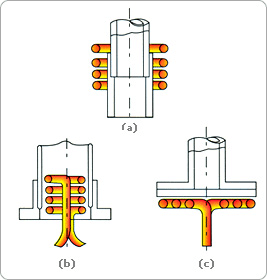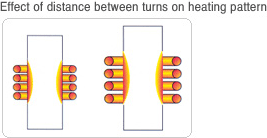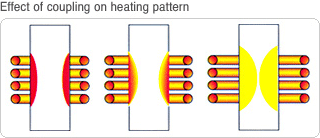Design of High-Frequency Coil
Design of High-Frequency Coil
The success of high-frequency brazing depends on the size, shape, distance, etc. of the heating coil (inducer) relative to the heated object.
The heating coil should be capable of uniform heating, have good heating efficiency and mechanical strength and precision. The heating coil is usually made of a solid pipe wound once or multiple times and must be water cooled to enable flow of high-frequency high current. For simple shapes, the coil design is easy, but in case of complex shapes, the coil design is difficult and calculation is impossible therefore often relying on experience and skills. The basic shape of a heating coil is often designed by inverting the outside, inside and plane of the heated object, respectively, as shown in the figure at the right.
(a) is the most basic shape and used most frequently.
(b) is less efficient than (a), but is used when the internal pipe is not heated.
(c) is used for plane heating or if continuous heating is performed without moving the heating coil.
The heating coil should be capable of uniform heating, have good heating efficiency and mechanical strength and precision. The heating coil is usually made of a solid pipe wound once or multiple times and must be water cooled to enable flow of high-frequency high current. For simple shapes, the coil design is easy, but in case of complex shapes, the coil design is difficult and calculation is impossible therefore often relying on experience and skills. The basic shape of a heating coil is often designed by inverting the outside, inside and plane of the heated object, respectively, as shown in the figure at the right.
(a) is the most basic shape and used most frequently.
(b) is less efficient than (a), but is used when the internal pipe is not heated.
(c) is used for plane heating or if continuous heating is performed without moving the heating coil.

Example of Coil Design







